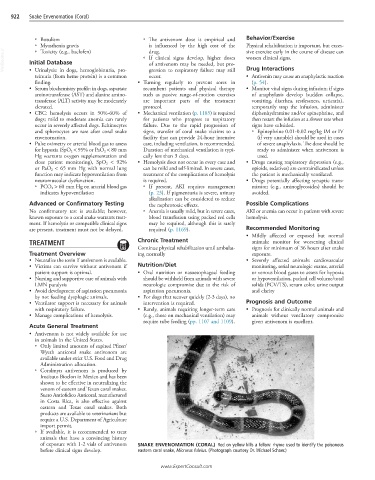Page 1839 - Cote clinical veterinary advisor dogs and cats 4th
P. 1839
922 Snake Envenomation (Coral)
○ Botulism ○ The antivenom dose is empirical and Behavior/Exercise
○ Myasthenia gravis is influenced by the high cost of the Physical rehabilitation is important, but exces-
VetBooks.ir Initial Database ○ If clinical signs develop, higher doses worsen clinical signs.
sive exercise early in the course of disease can
drug.
○ Toxicity (e.g., baclofen)
of antivenom may be needed, but pro-
Drug Interactions
• Urinalysis: in dogs, hemoglobinuria, pro-
teinuria (from heme protein) is a common gression to respiratory failure may still • Antivenin may cause an anaphylactic reaction
occur.
finding. • Turning regularly to prevent sores in (p. 54).
• Serum biochemistry profile: in dogs, aspartate recumbent patients and physical therapy • Monitor vital signs during infusion; if signs
aminotransferase (AST) and alanine amino- such as passive range-of-motion exercises of anaphylaxis develop (sudden collapse,
transferase (ALT) activity may be moderately are important parts of the treatment vomiting, diarrhea, restlessness, urticaria),
elevated. protocol. temporarily stop the infusion, administer
• CBC: hemolysis occurs in 50%-60% of • Mechanical ventilation (p. 1185) is required diphenhydramine and/or epinephrine, and
dogs; mild to moderate anemia can rarely for patients who progress to respiratory then restart the infusion at a slower rate when
occur in severely affected dogs. Echinocytes failure. Due to the rapid progression of signs have subsided.
and spherocytes are rare after coral snake signs, transfer of coral snake victims to a ○ Epinephrine 0.01-0.02 mg/kg IM or IV
envenomation. facility that can provide 24-hour intensive (if very unstable) should be used in cases
• Pulse oximetry or arterial blood gas to assess care, including ventilation, is recommended. of severe anaphylaxis. The dose should be
for hypoxia (SpO 2 < 95% or PaO 2 < 80 mm Duration of mechanical ventilation is typi- ready to administer when antivenom is
Hg warrants oxygen supplementation and cally less than 3 days. used.
close patient monitoring), SpO 2 < 92% • Hemolysis does not occur in every case and • Drugs causing respiratory depression (e.g.,
or PaO 2 < 65 mm Hg with normal lung can be mild and self-limited. In severe cases, opioids, sedatives) are contraindicated unless
function may indicate hypoventilation from treatment of the complications of hemolysis the patient is mechanically ventilated.
neuromuscular dysfunction. is required. • Drugs potentially affecting synaptic trans-
○ PCO 2 > 60 mm Hg on arterial blood gas ○ If present, AKI requires management mission (e.g., aminoglycosides) should be
indicates hypoventilation (p. 23). If pigmenturia is severe, urinary avoided.
alkalization can be considered to reduce
Advanced or Confirmatory Testing the nephrotoxic effects. Possible Complications
No confirmatory test is available; however, ○ Anemia is usually mild, but in severe cases, AKI or anemia can occur in patients with severe
known exposure to a coral snake warrants treat- blood transfusion using packed red cells hemolysis.
ment. If hemolysis or compatible clinical signs may be required, although this is rarely
are present, treatment must not be delayed. required (p. 1169). Recommended Monitoring
• Mildly affected or exposed but normal
TREATMENT Chronic Treatment animals: monitor for worsening clinical
Continue physical rehabilitation until ambulat- signs for minimum of 36 hours after snake
Treatment Overview ing normally exposure.
• Neutralize the toxin if antivenom is available. • Severely affected animals: cardiovascular
• Victims can survive without antivenom if Nutrition/Diet monitoring, serial neurologic exams, arterial
patient support is optimal. • Oral nutrition or nasoesophageal feeding or venous blood gases to assess for hypoxia
• Nursing and supportive care of animals with should be withheld from animals with severe or hypoventilation, packed cell volume/total
LMN paralysis neurologic compromise due to the risk of solids (PCV/TS), serum color, urine output
• Avoid development of aspiration pneumonia aspiration pneumonia. and clarity
by not feeding dysphagic animals. • For dogs that recover quickly (2-3 days), no
• Ventilator support is necessary for animals intervention is required. Prognosis and Outcome
with respiratory failure. • Rarely, animals requiring longer-term care • Prognosis for clinically normal animals and
• Manage complications of hemolysis. (e.g., those on mechanical ventilation) may animals without ventilatory compromise
require tube feeding (pp. 1107 and 1109). given antivenom is excellent.
Acute General Treatment
• Antivenom is not widely available for use
in animals in the United States.
○ Only limited amounts of expired Pfizer/
Wyeth anticoral snake antivenom are
available under strict U.S. Food and Drug
Administration allocation.
○ Coralmyn antivenom is produced by
Instituto Bioclon in Mexico and has been
shown to be effective in neutralizing the
venom of eastern and Texan coral snakes.
Suero Antiofidico Anticoral, manufactured
in Costa Rica, is also effective against
eastern and Texas coral snakes. Both
products are available to veterinarians but
require a U.S. Department of Agriculture
import permit.
○ If available, it is recommended to treat
animals that have a convincing history
of exposure with 1-2 vials of antivenom SNAKE ENVENOMATION (CORAL) Red on yellow kills a fellow: rhyme used to identify the poisonous
before clinical signs develop. eastern coral snake, Micrurus fulvius. (Photograph courtesy Dr. Michael Schaer.)
www.ExpertConsult.com

